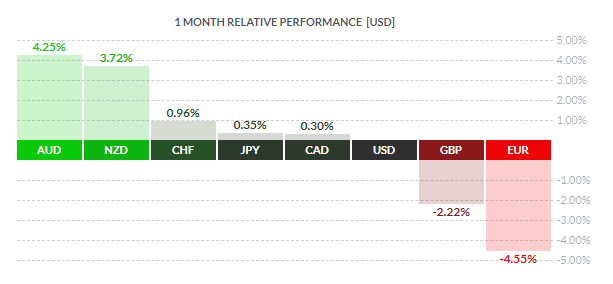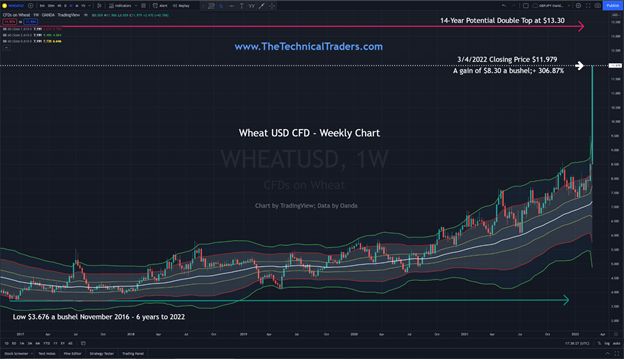Now is the time for traders to adapt to higher volatility and rapidly changing market conditions. One of the best ways to do this is to monitor different asset classes and track which investments are gaining and losing money flow. Knowing what the Best Asset Now is (BAN) is critical for consistent growth no matter the market condition.
With that said, buyers (countries, investors, and traders) are panicking as the commodity wheat, for example, gained more than 40% last week.
According to the U.S. Deptartment of Agriculture, China will hold 69% of the world’s corn reserves, 60% of rice and 51% of wheat by mid-2022.
Commodity markets surged to their largest gains in years as Ukrainian ports were closed and sanctions against Russia sent buyers scrambling for replacement supplies. Global commodities, commodity funds, and commodity ETFs are attracting huge capital inflows as investors seek to cash in on the rally in oil, metals, and grains.
How Does Russia–Ukraine War Affect Global Food Supplies?
The conflict between major commodity producers Russia and Ukraine is causing countries that rely heavily on commodity imports to feed their citizens to enter into panic buying. The breadbaskets of Ukraine and Russia account for more than 25% of the global wheat trade and nearly 20% of the global corn trade.
Last week, it was reported that many countries have dangerously low grain supplies. Nader Saad, an Egypt Cabinet spokesman, has raised the alarm that currently, Egypt has only nine months’ worth of wheat in silos. The supply includes five months of strategic reserves and four months of domestic production to cover the bread needs of 102 million Egyptians. Additionally, Avigdor Lieberman, Israel’s economic minister, said on Thursday (3/3/22) that his country should keep “a low profile” regarding the conflict in eastern Europe, given that Israel imports 50 percent of its wheat from Russia and 30 percent from Ukraine.
The longer-term potential for much higher grain prices exists, but it’s worth noting that Friday’s close of nearly $12.00 a bushel for wheat is not that far away from the all-time record high of $13.30, recorded 14-years ago. According to Trading Economics, wheat has gone up 75.08% year-to-date while other commodity markets like Oats are up a whopping 85.13%, Coffee 74.68%, and Corn 34.07%.
How Are Other Markets Reacting?
Year-to-date comparison returns as of 3/4/2022:
-9.18% S&P 500 (index), -7.49% Dow Jones Industrial Average (index), -15.21% NASDAQ (index), +37.44% Exxon Mobil (NYSE:XOM) (oil), +20.08% Freeport-McMoran (NYSE:FCX) (copper & gold), -20.68% Tesla (NASDAQ:TSLA) (alternative energy), -24.49% Microstrategy (NASDAQ:MSTR) (bitcoin play), -40.51% Meta Platforms (NASDAQ:FB) (social media)
As stock holdings and 401k’s are shrinking it may be time to re-evaluate your portfolio. There are ETFs available that can give you exposure to commodities, energy, and metals.
Here is an example of a few of these ETFs:
+53.81% Teucrium Wheat (NYSE:WEAT)
+41.79% iShares S&P GSCI Commodity-Indexed Trust (NYSE:GSG)
+104.40 ProShares Ultra Bloomberg Crude Oil (NYSE:UCO)
+59.32% Aberdeen Standard Physical Palladium Shares ETF (NYSE:PALL)
How Is Global Investor Reacting To Rocketing Commodity Prices And Increasing Market Volatility?
We can track global money flow by monitoring the following 1-month currency graph (www.finviz.com). The Australian dollar is up +4.25%, the Australian dollar +3.72%, and the Canadian dollar +0.30% vs. the US dollar due to the rising commodity prices like metals and energy. These country currencies are known as commodity currencies.
The Switzerland franc +0.96%, the Japanese yen +0.35%, and the US dollar +0.00% are all benefiting from global capital seeking a safe haven. As volatility continues to spike, these country currencies will experience more inflows as capital comes out of depreciating assets and seeks stability.
We also notice that capital outflow is occurring from the European Union-Eurodollar-4.55% and the British pound -2.22% due to their close proximity (risk) to the Russia - Ukraine war.

Global Central Banks Will Need To Begin Raising Interest Rates To Combat High Inflation
Due to the rapid acceleration of inflation, the US Federal Reserve may have been looking to raise interest rates by 50 basis points at its policy meeting two weeks from now. However, given Russia’s invasion of Ukraine, the FED may become more cautious and consider raising interest rates by only 25 basis points on March 15-16.

